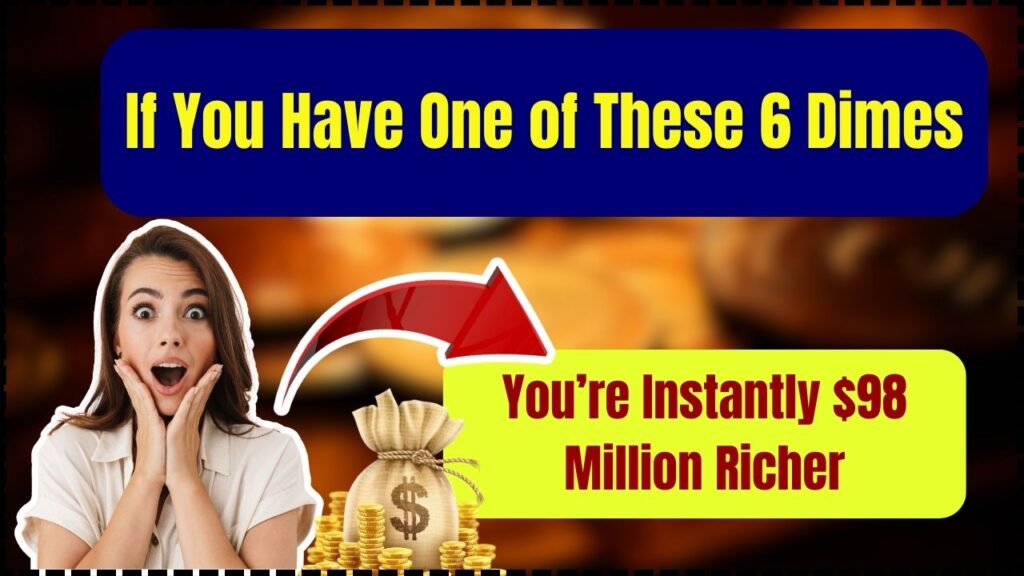If You Have One of These 6 Dimes: Have you ever taken a moment to really examine the change rattling around in your pocket or resting at the bottom of a jar on your dresser? You might be surprised to learn that some of those old coins could be worth a small fortune. In fact, if you have one of these 6 dimes, you’re instantly $98 million richer — or at least that’s what the viral internet headlines boldly claim. While such a figure is most likely exaggerated, there is real, tangible value hiding in certain rare coins, and learning how to identify them can potentially change your financial life.

In this expert-curated guide, we’ll explore six of the most valuable dimes in United States coin history. We’ll also provide insights into how coin values are determined, bust the myths behind inflated claims, and offer a detailed, step-by-step checklist to help you identify whether that old dime in your drawer is just spare change or a hidden treasure. Whether you’re a beginner curious about coin collecting or a seasoned numismatist, this guide is packed with value.
If You Have One of These 6 Dimes
| Feature | Details |
|---|---|
| Top Dime Value | 1894-S Barber Dime sold for nearly $2 million |
| Rarest Dime | 1894-S Barber Dime (only 24 minted, ~9 known to exist) |
| Other Valuable Dimes | 1916-D Mercury, 1942/1 Mercury Overdate, 1975 No-S Roosevelt, 1968 No-S Roosevelt |
| Myth Alert | No dime has sold for $98 million (yet!) |
| Trusted Coin Resource | Professional Coin Grading Service (PCGS) |
The notion that a simple dime could make you a millionaire isn’t entirely fantasy. While the $98 million claim might be overblown, coins like the 1894-S Barber Dime and 1975 No-S Roosevelt Dime prove that some change really is worth chasing. Whether you’re an amateur enthusiast or an advanced collector, recognizing key signs of rarity, understanding grading, and using expert resources can dramatically increase your chances of finding treasure in unexpected places.
What Makes a Dime Valuable?
To truly understand why some dimes are worth so much more than ten cents, it’s helpful to know what factors influence coin value. There are a few major elements that contribute to the rarity and desirability of certain coins, particularly dimes:
1. Mintage Numbers
Coins that were minted in small quantities are inherently rarer. Some of the most valuable coins were never intended to be released to the public or had very limited runs due to historical or logistical reasons.
2. Errors and Variants
Mistakes happen, even in minting. Coins with errors like missing mint marks, double strikes, or overdates are often highly collectible. These “error coins” stand out as anomalies and are often worth much more than their face value.
3. Condition and Grade
The overall physical state of a coin is a huge factor. Grading systems like those from PCGS or NGC assess coins on a 1-70 scale. A higher grade (usually MS-65 or above) means the coin has little to no wear and is more valuable.
4. Historical Significance
Coins tied to major events in U.S. history, major design changes, or first-year issues tend to attract attention and demand from collectors.
5. Demand Among Collectors
Even if a coin is rare, it must be in demand to be valuable. Some dimes are more coveted due to their beauty, design, or historical backstory.
The 6 Most Valuable Dimes You Should Know
Let’s break down these amazing coins one by one:
1. 1894-S Barber Dime
- Why it’s valuable: Only 24 were minted in San Francisco, and fewer than 10 are believed to exist today. It’s a true collector’s gem.
- Estimated Value: Up to $2 million at public auction; private sales may be even higher.
- Fun Fact: Legend has it that the mint superintendent gave some of the dimes to his daughter, who spent one on ice cream!
2. 1916-D Mercury Dime
- Why it’s valuable: This was the first year of the iconic Mercury design, and the Denver Mint produced only 264,000 pieces.
- Estimated Value: Ranges from $1,000 for low-grade coins to over $200,000 for uncirculated, mint-condition examples.
- How to Identify: Look for the “D” mintmark on the reverse near the bottom left. It’s crucial for authentication.
3. 1942/1 Mercury Dime (Overdate Error)
- Why it’s valuable: This error occurred when a “2” was struck over a “1” in the date, due to an improperly prepared die.
- Estimated Value: Between $500 and $5,000+, depending on condition.
- Collector Tip: Use a jeweler’s loupe to spot the overdate on the coin’s obverse. It’s subtle but visible.
4. 1975 No-S Roosevelt Dime
- Why it’s valuable: Intended only as a proof coin for collectors, a few were released without the San Francisco “S” mintmark. Only two confirmed examples exist.
- Estimated Value: Exceeds $500,000 in private transactions and auctions.
- Rarity Note: This is considered one of the most famous modern coin errors.
5. 1968 No-S Roosevelt Dime
- Why it’s valuable: Like the 1975 error, this proof coin lacks the “S” mintmark. Proof coins are not meant for circulation, making this even rarer.
- Estimated Value: Between $10,000 and $20,000 depending on condition and buyer demand.
- Important: These dimes were never distributed through banks or stores.
6. Bonus Mention: 1976 Bicentennial Quarter (No-S)
- This one isn’t a dime, but it’s frequently mentioned in online lists and viral videos.
- Fact Check: No confirmed $94 million sale exists. However, genuine mint errors can still be valuable.
- Expert Insight: Always confirm a coin’s story and provenance before assuming it’s a fortune.
Check If Your Dime Is Valuable
Ready to do some treasure hunting? Here’s how you can systematically check your coins:
- Examine the Date and Mint Mark: Most mint marks can be found on the reverse (back) side of the coin. A missing or unexpected mint mark is a red flag for potential value.
- Check for Errors: Use a magnifier to look for obvious or subtle anomalies: doubled lettering, off-center strikes, re-punched dates, or overstruck numbers.
- Compare to Known Examples: Sites like PCGS, NGC, and Coin World offer excellent photo comparisons and auction records.
- Get It Professionally Graded: If you’re serious, grading adds credibility and market value. Both PCGS and NGC are top-tier services with online submission options.
- Consult a Numismatist: A certified dealer can offer a second opinion and help you sell your coin through the right channels. Use ANA to find trusted experts near you.
- Track Market Trends: The coin market fluctuates. A coin worth $5,000 today might fetch $10,000 next year. Keep tabs on collector forums and auction sites.
Up To $764 For These 10 Rare Coins with Iconic Designs: Do You Own One?
Rare 1917-S Buffalo Nickel – Could You Be Holding a Valuable Coin?
What Apple’s $500 Billion Expansion Means for Texas and the Entire USA: Check Details!
FAQs On If You Have One of These 6 Dimes
Is it true a dime can be worth $98 million?
No dime has sold for that amount. While the number makes for a great headline, it’s an exaggeration. The highest confirmed dime sales are in the $1-$2 million range.
Can I find these valuable dimes in my change?
Finding one in circulation is incredibly rare. Most were either never released to the public or were removed from circulation by collectors decades ago.
Where can I sell a rare dime?
Auction houses like Heritage Auctions, Stack’s Bowers, and eBay (with proper authentication) are good places to sell. Ensure your coin is graded first.
How do I avoid counterfeit coins?
Stick with certified dealers. Ask for third-party grading reports from PCGS or NGC. Be wary of deals that seem too good to be true.
Should I clean my coins before selling?
Absolutely not. Cleaning a coin can drastically reduce its value. Collectors and graders prefer coins in their original condition, even if they look worn.








